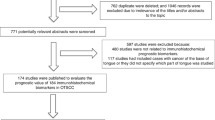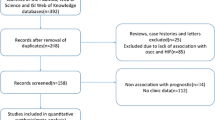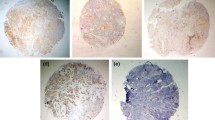Abstract
The objective of the study was to examine the prognostic value of hypoxia-inducible factor-1α (HIF-1α), carbonic anhydrase-IX (CA-IX), cyclooxygenase-2 (COX-2), Ki-67, and erythropoietin receptor in patients with oral tongue squamous cell carcinoma. Immunohistochemical analysis of marker expression was performed on tissue samples from 25 patients with tongue squamous cell carcinoma. The Kaplan–Meier method, univariate and multivariate analyses, and the Cox proportional hazards model were used to examine associations between patient and tumor characteristics, and the immunohistochemical results and disease-specific survival. There was no association between the expression of the five markers and disease-specific survival, and there was no statistically significant difference in the hazards ratio according to postoperative radiotherapy. There was no correlation between marker expression and prognosis. There was no association between marker expression and radioresistance or disease-specific survival. Therefore, HIF-1α, CA-IX, COX-2, Ki-67, and erythropoietin receptor are not suitable prognostic markers for tongue squamous cell carcinoma.


Similar content being viewed by others

References
Schrijvers ML, van der Laan BF, de Bock GH, Pattje WJ, Mastik MF, Menkema L, Langendijk JA, Kluin PM, Schuuring E, van der Wal JE (2008) Overexpression of intrinsic hypoxia markers HIF1alpha and CA-IX predict for local recurrence in stage T1–T2 glottic laryngeal carcinoma treated with radiotherapy. Int J Radiat Oncol Biol Phys 72:161–169
Moeller BJ, Richardson RA, Dewhirst MW (2007) Hypoxia and radiotherapy: opportunities for improved outcomes in cancer treatment. Cancer Metastasis Rev 26:241–248
Vordermark D, Brown JM (2003) Endogenous markers of tumor hypoxia predictors of clinical radiation resistance? Strahlenther Onkol 179:801–811
Warnakulasuriya S (2009) Global epidemiology of oral and oropharyngeal cancer. Oral Oncol 45:309–316
Ferlay J, Shin HR, Bray F, Forman D, Mathers C, Parkin DM (2008) Estimates of worldwide burden of cancer in: GLOBOCAN 2008. Int J Cancer 127:2893–2917
Suslu N, Hosal AS, Aslan T, Sozeri B, Dolgun A (2013) Carcinoma of the oral tongue: a case series analysis of prognostic factors and surgical outcomes. J Oral Maxillofac Surg 71:1283–1290
Gueiros LA, Coletta RD, Kowalski LP, Lopes MA (2011) Clinicopathological features and proliferation markers in tongue squamous cell carcinomas. Int J Oral Maxillofac Surg 40:510–515
Bettendorf O, Piffko J, Bankfalvi A (2004) Prognostic and predictive factors in oral squamous cell cancer: important tools for planning individual therapy? Oral Oncol 40:110–119
Liang X, Zheng M, Jiang J, Zhu G, Yang J, Tang Y (2011) Hypoxia-inducible factor-1 alpha, in association with TWIST2 and SNIP1, is a critical prognostic factor in patients with tongue squamous cell carcinoma. Oral Oncol 47:92–97
Dunkel J, Vaittinen S, Grenman R, Kinnunen I, Irjala H (2013) Prognostic markers in stage I oral cavity squamous cell carcinoma. Laryngoscope 123:2435–2441
Kim SJ, Shin HJ, Jung KY, Baek SK, Shin BK, Choi J, Kim BS, Shin SW, Kim YH, Kim JS, Oosterwijk E (2007) Prognostic value of carbonic anhydrase IX and Ki-67 expression in squamous cell carcinoma of the tongue. Jpn J Clin Oncol 37:812–819
Li HG, Li JS, Chen WL, Wang L, Wu DH, Lin ZY (2009) Prognostic significance of erythropoietin and erythropoietin receptor in tongue squamous cell carcinoma. Br J Oral Maxillofac Surg 47:470–475
Wang YH, Wu MW, Yang AK, Zhang WD, Sun J, Liu TR, Chen YF (2011) COX-2 Gene increases tongue cancer cell proliferation and invasion through VEGF-C pathway. Med Oncol 28(Suppl 1):S360–S366
Sittel C, Ruiz S, Volling P, Kvasnicka HM, Jungehulsing M, Eckel HE (1999) Prognostic significance of Ki-67 (MIB1), PCNA and p53 in cancer of the oropharynx and oral cavity. Oral Oncol 35:583–589
Jonathan RA, Wijffels KI, Peeters W, de Wilde PC, Marres HA, Merkx MA, Oosterwijk E, van der Kogel AJ, Kaanders JH (2006) The prognostic value of endogenous hypoxia-related markers for head and neck squamous cell carcinomas treated with ARCON. Radiother Oncol 79:288–297
Vaupel P, Mayer A (2007) Hypoxia in cancer: significance and impact on clinical outcome. Cancer Metastasis Rev 26:225–239
Conflict of interest
The authors declare no conflicts of interest, financial or otherwise.
Author information
Authors and Affiliations
Corresponding author
Additional information
J. S. Hwa and O. J. Kwon made an equal contribution to the manuscript.
Rights and permissions
About this article
Cite this article
Hwa, J.S., Kwon, O.J., Park, J.J. et al. The prognostic value of immunohistochemical markers for oral tongue squamous cell carcinoma. Eur Arch Otorhinolaryngol 272, 2953–2959 (2015). https://doi.org/10.1007/s00405-014-3254-5
Received:
Accepted:
Published:
Issue Date:
DOI: https://doi.org/10.1007/s00405-014-3254-5



